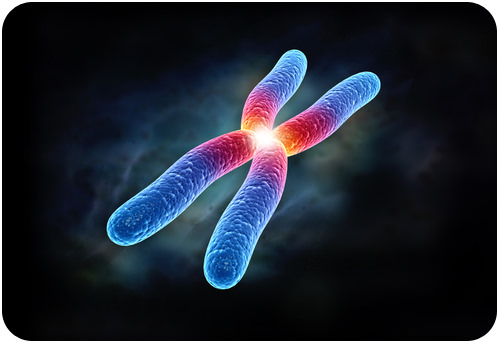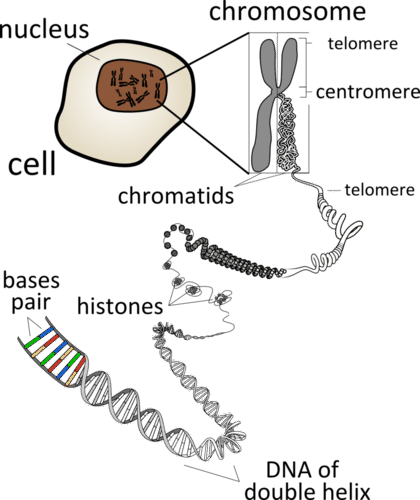3.15: Human Chromosomes
- Page ID
- 12064
\( \newcommand{\vecs}[1]{\overset { \scriptstyle \rightharpoonup} {\mathbf{#1}} } \)
\( \newcommand{\vecd}[1]{\overset{-\!-\!\rightharpoonup}{\vphantom{a}\smash {#1}}} \)
\( \newcommand{\dsum}{\displaystyle\sum\limits} \)
\( \newcommand{\dint}{\displaystyle\int\limits} \)
\( \newcommand{\dlim}{\displaystyle\lim\limits} \)
\( \newcommand{\id}{\mathrm{id}}\) \( \newcommand{\Span}{\mathrm{span}}\)
( \newcommand{\kernel}{\mathrm{null}\,}\) \( \newcommand{\range}{\mathrm{range}\,}\)
\( \newcommand{\RealPart}{\mathrm{Re}}\) \( \newcommand{\ImaginaryPart}{\mathrm{Im}}\)
\( \newcommand{\Argument}{\mathrm{Arg}}\) \( \newcommand{\norm}[1]{\| #1 \|}\)
\( \newcommand{\inner}[2]{\langle #1, #2 \rangle}\)
\( \newcommand{\Span}{\mathrm{span}}\)
\( \newcommand{\id}{\mathrm{id}}\)
\( \newcommand{\Span}{\mathrm{span}}\)
\( \newcommand{\kernel}{\mathrm{null}\,}\)
\( \newcommand{\range}{\mathrm{range}\,}\)
\( \newcommand{\RealPart}{\mathrm{Re}}\)
\( \newcommand{\ImaginaryPart}{\mathrm{Im}}\)
\( \newcommand{\Argument}{\mathrm{Arg}}\)
\( \newcommand{\norm}[1]{\| #1 \|}\)
\( \newcommand{\inner}[2]{\langle #1, #2 \rangle}\)
\( \newcommand{\Span}{\mathrm{span}}\) \( \newcommand{\AA}{\unicode[.8,0]{x212B}}\)
\( \newcommand{\vectorA}[1]{\vec{#1}} % arrow\)
\( \newcommand{\vectorAt}[1]{\vec{\text{#1}}} % arrow\)
\( \newcommand{\vectorB}[1]{\overset { \scriptstyle \rightharpoonup} {\mathbf{#1}} } \)
\( \newcommand{\vectorC}[1]{\textbf{#1}} \)
\( \newcommand{\vectorD}[1]{\overrightarrow{#1}} \)
\( \newcommand{\vectorDt}[1]{\overrightarrow{\text{#1}}} \)
\( \newcommand{\vectE}[1]{\overset{-\!-\!\rightharpoonup}{\vphantom{a}\smash{\mathbf {#1}}}} \)
\( \newcommand{\vecs}[1]{\overset { \scriptstyle \rightharpoonup} {\mathbf{#1}} } \)
\( \newcommand{\vecd}[1]{\overset{-\!-\!\rightharpoonup}{\vphantom{a}\smash {#1}}} \)
\(\newcommand{\avec}{\mathbf a}\) \(\newcommand{\bvec}{\mathbf b}\) \(\newcommand{\cvec}{\mathbf c}\) \(\newcommand{\dvec}{\mathbf d}\) \(\newcommand{\dtil}{\widetilde{\mathbf d}}\) \(\newcommand{\evec}{\mathbf e}\) \(\newcommand{\fvec}{\mathbf f}\) \(\newcommand{\nvec}{\mathbf n}\) \(\newcommand{\pvec}{\mathbf p}\) \(\newcommand{\qvec}{\mathbf q}\) \(\newcommand{\svec}{\mathbf s}\) \(\newcommand{\tvec}{\mathbf t}\) \(\newcommand{\uvec}{\mathbf u}\) \(\newcommand{\vvec}{\mathbf v}\) \(\newcommand{\wvec}{\mathbf w}\) \(\newcommand{\xvec}{\mathbf x}\) \(\newcommand{\yvec}{\mathbf y}\) \(\newcommand{\zvec}{\mathbf z}\) \(\newcommand{\rvec}{\mathbf r}\) \(\newcommand{\mvec}{\mathbf m}\) \(\newcommand{\zerovec}{\mathbf 0}\) \(\newcommand{\onevec}{\mathbf 1}\) \(\newcommand{\real}{\mathbb R}\) \(\newcommand{\twovec}[2]{\left[\begin{array}{r}#1 \\ #2 \end{array}\right]}\) \(\newcommand{\ctwovec}[2]{\left[\begin{array}{c}#1 \\ #2 \end{array}\right]}\) \(\newcommand{\threevec}[3]{\left[\begin{array}{r}#1 \\ #2 \\ #3 \end{array}\right]}\) \(\newcommand{\cthreevec}[3]{\left[\begin{array}{c}#1 \\ #2 \\ #3 \end{array}\right]}\) \(\newcommand{\fourvec}[4]{\left[\begin{array}{r}#1 \\ #2 \\ #3 \\ #4 \end{array}\right]}\) \(\newcommand{\cfourvec}[4]{\left[\begin{array}{c}#1 \\ #2 \\ #3 \\ #4 \end{array}\right]}\) \(\newcommand{\fivevec}[5]{\left[\begin{array}{r}#1 \\ #2 \\ #3 \\ #4 \\ #5 \\ \end{array}\right]}\) \(\newcommand{\cfivevec}[5]{\left[\begin{array}{c}#1 \\ #2 \\ #3 \\ #4 \\ #5 \\ \end{array}\right]}\) \(\newcommand{\mattwo}[4]{\left[\begin{array}{rr}#1 \amp #2 \\ #3 \amp #4 \\ \end{array}\right]}\) \(\newcommand{\laspan}[1]{\text{Span}\{#1\}}\) \(\newcommand{\bcal}{\cal B}\) \(\newcommand{\ccal}{\cal C}\) \(\newcommand{\scal}{\cal S}\) \(\newcommand{\wcal}{\cal W}\) \(\newcommand{\ecal}{\cal E}\) \(\newcommand{\coords}[2]{\left\{#1\right\}_{#2}}\) \(\newcommand{\gray}[1]{\color{gray}{#1}}\) \(\newcommand{\lgray}[1]{\color{lightgray}{#1}}\) \(\newcommand{\rank}{\operatorname{rank}}\) \(\newcommand{\row}{\text{Row}}\) \(\newcommand{\col}{\text{Col}}\) \(\renewcommand{\row}{\text{Row}}\) \(\newcommand{\nul}{\text{Nul}}\) \(\newcommand{\var}{\text{Var}}\) \(\newcommand{\corr}{\text{corr}}\) \(\newcommand{\len}[1]{\left|#1\right|}\) \(\newcommand{\bbar}{\overline{\bvec}}\) \(\newcommand{\bhat}{\widehat{\bvec}}\) \(\newcommand{\bperp}{\bvec^\perp}\) \(\newcommand{\xhat}{\widehat{\xvec}}\) \(\newcommand{\vhat}{\widehat{\vvec}}\) \(\newcommand{\uhat}{\widehat{\uvec}}\) \(\newcommand{\what}{\widehat{\wvec}}\) \(\newcommand{\Sighat}{\widehat{\Sigma}}\) \(\newcommand{\lt}{<}\) \(\newcommand{\gt}{>}\) \(\newcommand{\amp}{&}\) \(\definecolor{fillinmathshade}{gray}{0.9}\)
Coiled bundles of DNA and proteins, containing hundreds or thousands of genes. What are these things?
Chromosomes. These ensure that each cell receives the proper amount of DNA during cell division. And usually people have 46 of them, 23 from each parent.
Chromosomes and Genes
Each species has a characteristic number of chromosomes. Chromosomes are coiled structures made of DNA and proteins called histones (Figure below). Chromosomes are the form of the genetic material of a cell during cell division. See the "Chromosomes" concept for additional information.
 The human genome has 23 pairs of chromosomes located in the nucleus of somatic cells. Each chromosome is composed of genes and other DNA wound around histones (proteins) into a tightly coiled molecule.
The human genome has 23 pairs of chromosomes located in the nucleus of somatic cells. Each chromosome is composed of genes and other DNA wound around histones (proteins) into a tightly coiled molecule.The human species is characterized by 23 pairs of chromosomes, as shown in the Figure below.
 Human Chromosomes. Humans have 23 pairs of chromosomes. Pairs 1-22 are autosomes. Females have two X chromosomes, and males have an X and a Y chromosome.
Human Chromosomes. Humans have 23 pairs of chromosomes. Pairs 1-22 are autosomes. Females have two X chromosomes, and males have an X and a Y chromosome.Autosomes
Of the 23 pairs of human chromosomes, 22 pairs are autosomes (numbers 1–22 in the Figure above). Autosomes are chromosomes that contain genes for characteristics that are unrelated to sex. These chromosomes are the same in males and females. The great majority of human genes are located on autosomes.
Sex Chromosomes
The remaining pair of human chromosomes consists of the sex chromosomes, X and Y. Females have two X chromosomes, and males have one X and one Y chromosome. In females, one of the X chromosomes in each cell is inactivated and known as a Barr body. This ensures that females, like males, have only one functioning copy of the X chromosome in each cell.
As you can see from the Figures above, the X chromosome is much larger than the Y chromosome. The X chromosome has about 2,000 genes, whereas the Y chromosome has fewer than 100, none of which are essential to survival. (For comparison, the smallest autosome, chromosome 22, has over 500 genes.) Virtually all of the X chromosome genes are unrelated to sex. Only the Y chromosome contains genes that determine sex. A single Y chromosome gene, called SRY (which stands for sex-determining region Y gene), triggers an embryo to develop into a male. Without a Y chromosome, an individual develops into a female, so you can think of female as the default sex of the human species. Can you think of a reason why the Y chromosome is so much smaller than the X chromosome?
Human Genes
Humans have an estimated 20,000 to 22,000 genes. This may sound like a lot, but it really isn’t. Far simpler species have almost as many genes as humans. However, human cells use splicing and other processes to make multiple proteins from the instructions encoded in a single gene. Of the 3 billion base pairs in the human genome, only about 25 percent make up genes and their regulatory elements. The functions of many of the other base pairs are still unclear.
The majority of human genes have two or more possible alleles, which are alternative forms of a gene. Differences in alleles account for the considerable genetic variation among people. In fact, most human genetic variation is the result of differences in individual DNA bases within alleles.
Further Reading
Summary
- Humans have 23 pairs of chromosomes. Of these, 22 pairs are autosomes.
- The X and Y chromosomes are the sex chromosomes. Females have two X chromosomes, and males have one X and one Y.
- Human chromosomes contain a total of 20,000 to 22,000 genes, the majority of which have two or more alleles.
Review
- Describe human chromosomes.
- Compare and contrast human autosomes and sex chromosomes.
- What is SRY?
- Why are females the "default sex" of the human species?
| Image | Reference | Attributions |
 |
[Figure 1] | Credit: Mariana Ruiz Villarreal (LadyofHats) for CK-12 Foundation Source: CK-12 Foundation License: CC BY-NC |
 |
[Figure 2] | Credit: User:KES47/Wikimedia Commons Source: commons.wikimedia.org/wiki/File:Chromosome_en.svg License: CC BY 3.0 |
 |
[Figure 3] | Credit: Mariana Ruiz Villarreal (LadyofHats) for CK-12 Foundation Source: CK-12 Foundation License: CC BY-NC 3.0 |

